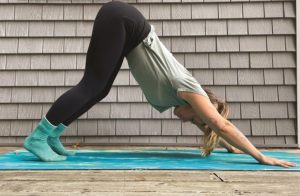After 15 years of both classical and new-age yoga training, I still find my home practice beginning the same way. Somewhere in the first five minutes: tabletop, on hands and knees. Cat and cow, moving between a back bend and rounded spine. Downward facing dog. What once was a way to become present in my body slips into routine.
Our minds love repetition. We find the grooved path and stick to it. It wasn’t until I started experiencing pain in my yoga practice that I began to suspect something might be wrong with my usual movement patterns.
If this was an injury, it was nothing major. No cracked vertebrae from a failed middle-of-the-room handstand. No terrible hands-on adjustment that slipped a disc. Just low back pain. A sure sign of adulthood, and, if we’re being honest, a common complaint among yoga practitioners.
I listened to several yoga students who came to me with the same pain. It ran along the lower QL region — the quadratus luborum, the deep abdominal muscle in the lower back. The erector spinae muscles along the spine were also super tight. The pain was a low, dull ache.
I had chalked it up to my free time spent surfing, an experience of arching your back for long periods while paddling. But these were folks who’d never lay down on fiberglass. What we had in common was steady yoga practice.
There are many roads that lead to back pain, and everyone should seek their own professional help. I turned to Beth Lewis, a movement educator in New York City. I know of several notable movement professionals who’ve worked with her, and, because of the pandemic, she was easily accessible via Zoom. Beth often says, “There is no bad posture, only fixed posture. If your spine can move freely, you’re good.”
Through painstakingly specific exercises, we found that my lumbar spine had been doing most of the lifting, literally and figuratively, in my daily life. My rib cage was constantly locked up and extending outward. I looked like I had excellent posture. But what I really had was a fixed posture.
Looking around at my fellow yoga teachers, I realized that many of us have it. Rib cage slightly outward, a focus on broadening collarbones, shoulder blades down the back. It is in the language and cueing of many of our classical yoga postures. A proud chest. A pronounced inward curve of the lumbar spine. In the past 10 years, I’ve seen and felt the effects of a focus on back bending in many classes. “Tech neck” in headlines have made yoga teachers aware of the average Western body. We might have overcorrected a bit.
The culmination of any physical practice is that it starts to show on your body. It changes the way we inhale, the way we move and bear weight. Over the course of a year with Beth, I’ve begun to repattern the way I move — from how my hands land on the yoga mat, to unloading the lumbar spine, to understanding the relationship between scapulae and my rib cage.

To bring it full circle into my yoga practice, I didn’t need to completely redesign the wheel, just tweak it. In tabletop, I walk my hands out a little bit farther, so that the shoulders are not stacked over the wrists. Instead of extending (straightening) the elbows, I allow them to soften and bend. Rather than let the weight in my hands pour outward into the heels of my palms, I superglue my index finger knuckle down on the mat. I try to spin the points of my elbows backward in space, externally rotating my arm bones slightly so that the triceps can bear a bit of the weight. Then, when I move my spine between cat (rounded) and cow (extended), it is my spine that moves — not my spine being pushed around by lumbar action directed by extended elbows.
In downward facing dog, similar rules apply but in different locations. The hands stay the same, but as the hips lift, instead of straightening the legs, I bend my knees. This allows for a greater push into the hands as you lift the hips up, as if you’re ripping the yoga mat apart between your palms and feet. I often tell students to pretend that they’re closing a car door with too many groceries in their hands (anterior pelvic tilt) and to soften their rib cage with a sigh. That sigh will interrupt the tendency to reach the rib cage or head to the floor, dumping into the shoulder capsule and extending the lumbar spine further.
Are these adjustments magic? No, but they are practical. For those of us who’ve moved in one way for a long time, change is too often about moving on to the bigger, better, and flashier thing. Now, I am seeing another way to progress by bringing new eyes to a familiar place — returning to the basics and reworking them.



